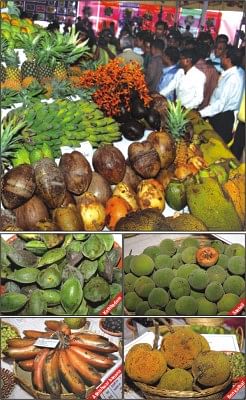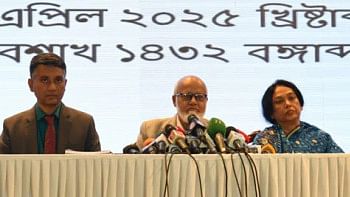<i>Sweet fragrance of season's fruits</i>

A fiesta of mouth-watering fruits has dazzled the city dwellers this week.
Hundreds of people are turning out to have a glimpse of as many as 70 varieties of fruits showcased at the exhibition and to have a taste of them too.
The sweet fragrance of the fruits reaches beyond the fair venue, Khamarbari, Farmgate, allowing those passing the nearby streets to feel the zest.
The three-day National Fruit Festival organised by the Department of Agricultural Extension (DAE) ends today. The fair is open from 9:00am to 9:00pm.
A total of 43 stalls have been set up at the fair participated by the fruit farmers from across the country and the DAE itself.
Fruits selected only from the gardens of promising farmers with outstanding performance found their place at the fair.
Some very unusual fruits attracted majority of the visitors. These include sour bilimbi, kathbadam, daofal, deua (monkey jack), golapjam (rose apple), santoil, toikar, fig, cowfal or cowa, lukluki, paanifal (water chestnut), gab (river ebony), agnishwar banana, longan, phalsa, ada jamir belonging to the citrus family at least ten times larger than the regular lemons and bon kathal belonging to the jackfruit family but sour in taste. These fruits are found in the wild all over Bangladesh and are not grown commercially.
Most popular fruits like mango, jackfruit, litchi, banana, guava and pineapple are also on display. A galore of 245 species of mango captivated the visitors. The rare ones include bou bhulani, khirshapati, lalmohon, krishanbhog, lota, dadbhog, devi, manjira, tikkafarash, ashwina, shubarna, bombai, lokhonbhog and many more.
The festival, however, has more serious objective than just to showcase the fruits and incite the senses of fruit-lovers. The organisers want to promote cultivation of fruit trees to become self-sufficient in fruit production and increase export in the long run highlighting its culinary delight and nutritious goodness.
Bangladesh currently exports around 20 metric tons of fruits to 35 countries a year.
Md Zahidul Amin, metropolitan agricultural officer, DAE, said, “Our aim is to popularise local fruits and to promote the unusual and almost extinct fruits that automatically grow in the wild but no longer reach our tables.”
“The festival will help create awareness among the people about the importance of fruits in our meals and their nutritious value," he added.
A grown person has the need for at least 60 to 80 grams of fruits per day, but average intake of most people in Bangladesh is around 35 grams.
The fair will also explore the opportunity of growing foreign fruits in Bangladesh that require similar environment, he said.
As an added charm, information is being disseminated about how to grow fruit trees and ways of processing and eating the delectable fruits.
Visitors, participants and experts at the fair expressed concern over the practice of using harmful chemical insecticides, fungicides and artificial hormones to accelerate fruit growth and use of artificial ripening agents by the commercial producers and sellers.
Use of chemicals during production increases the risk of environmental and health hazards, the observed.
Robin Mazumder, executive director, Central Extension Resource Development Institute, said, “Farmers are not at all educated enough about insecticides and fungicides in Bangladesh. After spraying these chemicals there is a certain waiting time before one can collect fruits and consume it. Commercial producers do not follow that rule.”
“Fruits do not ripe in the trees anymore. They are collected from the trees and ripened artificially with the help of chemical agents long before they mature. These fruits do not even taste good,” he added.
“However, farmers are changing the habit of using Carbide and Ethrel 39SL to ripen fruits after harvest. Planned Growth Regulator is being used which is less harmful. A level of awareness can be witnessed among consumers and producers,” he said.
The participants also raised concern about disappearance of local species of fruits.
According to the findings of a research conducted by Policy Research on Development Alternative (UBINIG), there are around five hundred mango species and sub species available in Bangladesh.
Raju Ahmed, managing director, Rajshahi Mango Product, said, “Majority of the varieties have gone extinct because commercial growers tend to plant only a few species which give higher yields, killing the diversified mango seedlings of the country.”
“Consumers are also satisfied with the very few varieties because they don't know about the species that disappeared from our culture,” he added.

 For all latest news, follow The Daily Star's Google News channel.
For all latest news, follow The Daily Star's Google News channel. 



Comments